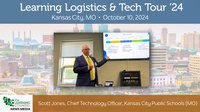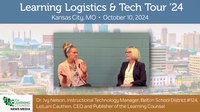The topic of resource management always grabs the attention of K-12 superintendents and administrators, simply because they know they need to optimize the limited resources they have if they’re going to maximize educational success. Striving to be more effective and more efficient at what we do is only natural, and the purpose of a resource management solution is to make managing resources easier.
Success stories such as higher test scores, learning improvements, and lower dropout rates are what we should be seeing in the news. Instead, these accomplishments are often overshadowed by news stories illustrating the tens of thousands of dollars of resources lost by individual schools to the tens of millions of dollars lost by school districts.
Here’s a startling statistic: 18 to 25 percent of district resources are lost or stolen every two to three years. The impact is that:
• Students don’t get what they need in order to be successful
• School budgets have to focus on replacing lost items rather than investing in new learning devices or materials
• Public confidence erodes when so many items are reported missing
One might expect to see textbooks, tablets, video cameras and projectors among the resources missing or misplaced, but how about pianos, weight machines, 3D printers, shop tools, bus tires and lawn tractors? They go missing, too.
Any resource management solution must be universal for managing all resources — educational items used directly by teachers and students in the classroom, front office resources used by administration and even those used for maintaining the school by the facility team.
Resources can be physical items such as laptops or textbooks, digital items such as eTextbooks, interactive courseware or learning databases or even services such as student tutoring or professional development. The goal of resource management is to provide a district-wide solution for managing all resources effectively and efficiently, a process that assigns accountability to stop losses and ensure resource availability for improved learning.
Districts need to know the value of what they have, where and how resources are allocated, how much of it is being used, and, in time, be able to correlate the investments to student learning results.
Managing the Process at All Levels
From a strategic perspective, educators need to see their total “investment” in what they have in a way they can’t glean from an accounting or budgeting process. Superintendents need to analyze how resources have been allocated across schools or subjects and what percentage is being used, plus correlate these resource investments with educational results as they try new and better ways to provide a learning experience.
Resource management essentially comes down to two major themes:
• Accountability. It is imperative to make sure every resource is assigned to an individual, department or location. It’s all about buying only what you need, better utilize what you have, and repurpose what remains — including selling, salvaging or disposing of unused resources.
• Availability. It is equally critical to ensure students have what they need, when they need it. Nothing reduces the number of lost or stolen items faster than by assigning accountability to an individual; whether they are a student, teacher or staff member. Having someone accept responsibility for the items assigned to them is the best way to ensure the items are secure, and can be accounted for when funding compliance audits are to be performed.
Being efficient in sharing resources also is a major factor in getting the most out of them. By taking a district-wide view, administrators can make fact-based decisions on what is available and purchase only what they need. Having a resource management solution that lets everyone know where excess resources are available and provides an easy process from transferring those items — and their value — from school A to school B is invaluable. Administrators also can see what percentage of resources is in use based on circulation statistics.
Lastly, a resource management solution helps districts to be prepared. Nearly every district is positioned in an area prone to some kind of natural disaster — think hurricanes, earthquakes, wildfires or tornados. As bad as these situations may be, they can be handled much easier and quicker if there is information documenting the value of what may have been lost but also what needs to be replaced.
The second major objective is to make sure resources are available. Students can’t achieve if they don’t have the things they need. Bottom line: It’s critical to have the right resources in the right hands at the right time for the right purpose. Currently, most districts that have a resource management solution use it to rollout laptops and/or tablets, as well as to manage textbooks and distribute digital eTextbooks to students. It also is often used to manage science equipment, special education, band instruments and more.
One district in northwest Illinois recently faced a dilemma familiar to many preK-12 districts: It was poised to begin the initial phases of a 1:1 transformation but took a look at the systems and processes in place for resource management, and realized they needed a better plan to distribute and manage all of the digital devices.
“This was a huge transition for our district, and we knew we needed to protect and make the most of our investment in the devices we were giving to kids, so we made the financial commitment to a universal resource management system,” said Lee Ann Taylor, district media services director for Barrington (Ill.) Community Unit 220 School District. “Now with our solution in place, we can issue laptops to an entire classroom in less than two minutes. Plus, we are easily able to track the number of devices remaining in each building so we can transfer as needed rather than purchasing new.”
Flexibility a Key
In addition to establishing accountability and providing availability, a resource management solution also must be able to handle any type of resource from physical to digital, plus services. Security levels must allow resources to be managed centrally at the district level, as well as by individual schools, separated by departments.
Most importantly, any solution needs to be flexible. For example, it must have the ability to define what is to be managed and to what extent with an unlimited number of categories and data fields defined by the user for each category. In addition, a solution must work with barcodes (or RFID tags) for tracking individual items or without barcodes by simply tracking item quantities, or both. For example, expensive items such as tablets or textbooks should be tagged but perhaps not the three-dollar graphic novel.
The ability to assign resources to classes and then automatically to students is a best-practice feature of a resource management solution. This “resource-to-class-to-student” relationship can easily identify every student having the resources he or she needs. In addition, having a single-page view showing every resource assigned to each student is crucial.
“The power of our inventory system is that it is patron-driven and allows us to track things by the patron,” Barrington’s Taylor said. “To keep track of everything on one student account is simply wonderful.”
The most important feature of any resource system is its ability to have audit trails. Managing resources that can easily be deleted without a record of it being captured has limited value. It’s essential a resource management solution keeps an audit trail and reports on every single transaction — forever.
In this time of educational transformation, as well as restricted budgets, a resource management solution is essential for any district to be more effective and efficient with their budget dollars in providing a greater learning experience. Most importantly, it is an opportunity to demonstrate management leadership and control to further build and instill public confidence.











